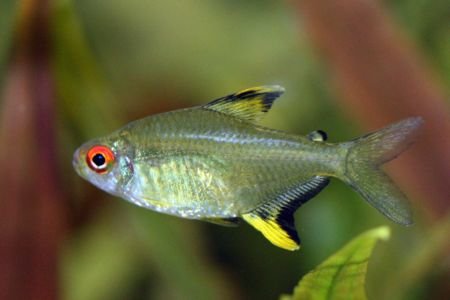Lemon Tetra Lifespan, Breeding, and Aggression Explained
Lemon Tetras are bright and peaceful fish. They are great for home tanks. Their yellow color and calm nature make them a top pick for many fish keepers.
If you want to keep them happy and healthy, it helps to know how long they live, how they breed, and if they get along with other fish. Let’s go over all of that, plus tips on tank setup, lighting, water care, and good tank mates.
How Long Do Lemon Tetras Live?
A healthy Lemon Tetra can live for 6 to 8 years, but most live around 4 to 6 years in home tanks.
You can help them live longer by giving good food, clean water, and a calm tank.
What helps them live longer:
- Water that stays stable (pH 5.5–7.5, temp 72–82°F)
- A mix of dry, live, and frozen food
- A calm space with no stress
- Weekly tank cleaning
How Long Do GloFish Tetras Live?
GloFish Tetras are like Black Skirt Tetras, but with bright colors. They often live 3 to 5 years. Their care is a lot like Lemon Tetras.
They are easy to keep, but breeding them is not allowed without a license. Like all fish, they live longer with clean water and good care.

Best Tank Setup for Lemon Tetras
To help your Lemon Tetras stay happy, make their tank feel like home.
Lighting
These fish like soft light. Too much light can stress them. Add tall or floating plants to block bright lights.
- Use light for 8–10 hours a day
- LED lights work best and save power
Tank Mates
Lemon Tetras are friendly and love to swim in groups. Keep at least 6 together so they feel safe. If kept alone or in pairs, they may hide or nip at others.
Good tank mates include:
- Neon Tetras
- Harlequin Rasboras
- Cory Catfish
- Dwarf Gouramis
- Guppies
- Cherry Barbs
- Big shrimp or snails
Avoid fish that nip fins or are too big, like Tiger Barbs or large Cichlids.
Water Changes
Clean water helps them live longer and stay healthy.
- Change 25–30% of the water every week
- Use a gravel cleaner to remove waste
- Always treat tap water to remove chlorine
- Check water often (ammonia, nitrites, nitrates)
Health Tips
Lemon Tetras are tough fish but can still get sick if the tank isn’t clean.
Common problems:
- Ich (white spots)
- Fin rot
- Swim bladder trouble
- Fungal spots
How to keep them healthy:
- Quarantine new fish before adding
- Don’t overfeed
- Keep water clean
- Give them different foods to boost their health
Lemon Tetra Breeding Made Easy
Breeding Lemon Tetras is fun and not too hard. With the right setup, even beginners can do it. These fish lay eggs and don’t care for their babies, so you’ll need to plan ahead.
Do Lemon Tetras Lay Eggs?
Yes, they do! Lemon Tetras are egg-scatterers. The female lays eggs in the tank, and the male swims over them to fertilize them.
But watch out—these fish eat their own eggs! So, you need a separate tank for breeding and must remove the parents right after they spawn.
How to Breed Lemon Tetras
Follow these steps to breed them the right way:
Pick a breeding pair:
Choose one male and one female. Males are slimmer and brighter. Females look rounder when full of eggs.
Feed them well:
Give them live or frozen foods like brine shrimp, daphnia, or bloodworms for 1–2 weeks. This helps them get ready to breed.
Move them to a breeding tank:
Place the pair in a special tank in the evening.
Watch for spawning:
- Spawning happens early in the morning.
- The male will chase the female and show bright colors.
- The female lays eggs on plants or in the gravel.
- She may lay 100–200 eggs at one time.
Take out the parents:
As soon as they lay eggs, remove both fish from the tank. This keeps the eggs safe.
Breeding Tank Setup
You don’t need a big tank. A small, quiet space works best.
- Tank size: 10–20 gallons is good
- Water temp: 78–82°F (25–28°C)
- pH level: 5.5–6.5 (soft and slightly acidic)
- Water hardness: Low (1–5 dGH)
- Lighting: Keep it dim. They like to spawn in low light
Bottom setup:
- Use marbles or mesh to keep eggs safe from being eaten
- Plants: Add Java moss or spawning mops. These give the eggs places to stick
- Filter: Use a sponge filter. It keeps the water clean and won’t suck up the eggs
- Cover: Use a lid. These fish can jump when they spawn
How to Care for Eggs and Fry
Once you take out the parents, it’s time to care for the eggs and baby fish (fry).
Egg Care
- Hatch time: Eggs hatch in 24–36 hours
- Light: Keep the tank dark to help more fry survive
- Fungus: Add a few drops of methylene blue to stop fungus from growing on the eggs
Fry Care
Feeding:
- Days 1–5: Feed infusoria or liquid baby fish food
- After Day 5: Start feeding baby brine shrimp or crushed flakes
Water changes:
- Change 10–20% of the water every other day. This keeps it clean
Growing up:
- In 3–4 weeks, the fry will look like small Lemon Tetras
- Wait until they are big enough before moving them to the main tank
Tips
Breeding Lemon Tetras is simple if you plan well. Set up a good tank, feed the pair high-protein food, and protect the eggs and fry. Soon, you’ll have a tank full of tiny, glowing fish!
Are Lemon Tetras Aggressive?
Lemon Tetras are calm and peaceful. They get along well with most fish. That’s why many people love them in community tanks.
But like other tetras, how they act depends on their tank, space, and friends.
Do Lemon Tetras Nip Fins?
Most of the time, they don’t nip. But they might nip if:
- They live in a group smaller than 6
- The tank is too small
- They feel stressed
- There are no hiding spots
- Water quality is poor
- They have bad tank mates
To keep them happy, keep at least 6–8 Lemon Tetras together. When they live in a school, they swim calmly and rarely cause problems.
Fin-nipping is rare, but it’s still smart to watch how they behave.

Which Tetras Are Aggressive?
Not all tetras are peaceful. Some are more likely to nip or act bossy.
Here are a few tetras known to be more aggressive:
- Serpae Tetra: Bright red and active, but often nip fins
- Buenos Aires Tetra: Larger and can act pushy or rough
- Black Skirt Tetra: Usually calm, but may nip in small groups
- Colombian Tetra: Often act bold or try to be the boss of the tank
If you want a peaceful tank, don’t mix these with slow or long-finned fish. You can keep them in big groups to reduce nipping.
Do GloFish Tetras Act Aggressive?
GloFish Tetras are just colorful Black Skirt Tetras. They look fun but can sometimes act out.
They may get nippy if:
- They are alone or in small groups
- The tank is too full
- The tank is dirty or stressful
- They don’t have enough space
To help GloFish Tetras stay calm:
- Keep them in groups of 5–6 or more
- Give them room to swim
- Avoid putting them with slow fish like Bettas or fancy Guppies
With the right care, GloFish Tetras can live peacefully in a shared tank.
Lemon Tetras are friendly and calm if kept right. Give them space, clean water, and plenty of friends. That way, they stay happy and won’t nip others.
If you want a calm tank, avoid the more aggressive tetras. Watch your fish and adjust if you see problems.
Lemon Tetra Diet & Size
Lemon Tetras are small, bright fish. To keep them healthy and happy, you need to feed them well and know how big they grow.
What Do Lemon Tetras Eat?
Lemon Tetras eat both plants and animals. They are not picky and enjoy many kinds of food.
Here’s what you can feed them:
- Tropical fish flakes
- Micro pellets for small fish
- Live foods like brine shrimp and bloodworms
- Frozen foods like mosquito larvae
- Soft veggies like spinach or zucchini (boiled first)
Give them different foods to help with color, growth, and health. Rotate their meals to keep them strong.
Best Foods for Lemon Tetras
Some great food choices are:
- TetraMin Flakes – daily food with key nutrients
- Hikari Micro Pellets – small and easy to eat
- Omega One Bloodworms – tasty and rich in protein
- NorthFin Community Pellets – made from whole fish
- Boiled peas or spinach – once a week treat
Feeding tip: Give small amounts once or twice a day. Only feed what they can eat in 2–3 minutes.
What Do Lemon Tetras Eat in the Wild?
In the wild, Lemon Tetras live in the slow rivers of Brazil. There, they eat:
- Bug larvae
- Tiny water animals
- Plants and algae
- Bits of leaves
- Small life in the water
In tanks, try to give a mix like this. Use flakes, frozen foods, and soft veggies. This helps them stay healthy.
How Big Do Lemon Tetras Get?
Lemon Tetras are small fish. Most grow to 1.5 to 2 inches long.
- Babies grow fast in the first few months
- Adults reach full size in about 6 to 9 months
- Males are slimmer and brighter
- Females are rounder, especially when full of eggs
Because they are small, they are great for small tanks. Still, they like space and should be in groups of 6 or more.

